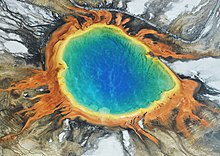Carotenoid

Carotenoids (or tetraterpenoids) are organic pigments. They are found in the chloroplasts and chromoplasts of plants, and also some bacteria and fungi.
The only animals known to produce carotenoids are aphids and mites, which got the genes from fungi.[1]
There are over 600 known carotenoids. They are of two types, xanthophylls (which contain oxygen) and carotenes (which are purely hydrocarbons with no oxygen).
Carotenoids have two key roles in plants and algae: they absorb light energy for use in photosynthesis, and they protect chlorophyll from photodamage.[2] Beta-carotene is the most common form in plants.
Some carotenoids (like β-carotene) have vitamin A activity (so they can convert to retinol). These and other carotenoids can also act as antioxidants. In the eye, certain other carotenoids (lutein, astaxanthin,[3] and zeaxanthin) apparently act directly to absorb damaging blue and near-ultraviolet light. This protects the macula of the retina, the part of the eye with the sharpest vision.
References[change | change source]
- ↑ Altincicek, Boran; Jennifer L. Kovacs & Nicole M. Gerardo (2011). "Horizontally transferred fungal carotenoid genes in the two-spotted spider mite Tetranychus urticae". Biology Letters. 8 (2): 253–257. doi:10.1098/rsbl.2011.0704. PMC 3297373. PMID 21920958.
{{cite journal}}: CS1 maint: multiple names: authors list (link) - ↑ Armstrong G.A. & Hearst J.E. (1996). "Carotenoids 2: Genetics and molecular biology of carotenoid pigment biosynthesis". FASEB J. 10 (2): 228–37. doi:10.1096/fasebj.10.2.8641556. PMID 8641556. S2CID 22385652.
- ↑ Kidd, Parris (2011). "Astaxanthin: cell membrane nutrient with diverse clinical benefits and anti-aging potential" (PDF). Alternative Medicine Review. 16 (4): 335–364. PMID 22214255. Archived from the original (PDF) on 2016-07-31. Retrieved 2016-01-13.
